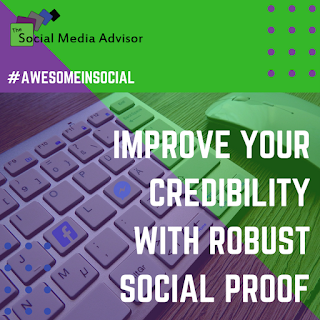#AwesomeInSocial – Improve Your Credibility with Robust Social Proof
Influence and word-of-mouth are cornerstones to your credibility. This builds social proof. Social proof is the social pressure for consumers to purchase a product or service based on the reviews and influence of others. The more social proof you have, the more customers and clients you’ll gain. It becomes easier as the social proof increases.
But how do you gain a robust social proof?
You gain it through testimonials, ratings and reviews, influencer endorsements, media logos, certifications, subscriber counts, social connections, social shares, clients, and case studies.
Testimonials
A testimonial is a statement made by a customer or consumer that provides an objective viewpoint. This “outsider influence” is something you’ll see more of in this list. It’s important to note that testimonials involve stories about how your product or service bettered their lives in some way. It’s similar, but not the same, as reviews.
Ratings and Reviews
Think about the last time you purchased something online. If the rating was available, did you look at it? Did it influence your buying decision? Of course it did. And if reviews were available, you likely read a few of those as well. The scoring system of a rating is a powerful influence in social proof. A review usually accompanies a rating. The greater your number of ratings and reviews, the more power it holds over the viewing public.
Influencer Endorsements
Influencer Endorsements aren’t the same as testimonials. An influencer is a well-known person or business who has a heavy social media following. A mention of your business, product, or service can cause an instant rise in social proof. It’s a mutually beneficial relationship, as your willingness to connect with them builds their credibility. Keep in mind that their reputation is just as important as yours.
Media Logos
You’ve noticed these before, and likely didn’t realize it. “As seen on…” is an excellent example. It’s important to note, you can only use these media logos if you’ve actually appeared on their networks, in their paper, etc. Misrepresentation of your credentials will destroy the credibility you’ve tried so hard to develop.
Certifications and Case Studies
Certifications and case studies are professional endorsements of your credibility. They prove your expertise, and therefore increase your social proof.
Subscriber Counts, Social Connections, and Social Shares
All of these combined build a pressing need to go along with the crowd. Like reviews and testimonials, the more you have, the more you’ll gain. It may take five years to get 10k subscribers, but the next 10k could take one or less. The more influence you have socially, the more people accept your credibility.
Clients and Word of Mouth
Word of mouth is still as strong as ever. People are more influenced by those they know than those they don’t. If a happy client spreads the word about your work, social proof will naturally follow.
Now you know the best ways to build your social proof. Building momentum is key to successfully enhancing your credibility. Take the time to do it right, and you’ll be #AwesomeInSocial.
Be sure to Follow us and Let’s Engage!
Hollie Clere of The Social Media Advisor is a “#BeAwesome” Developer, Social Media, Brand Builder, Content Manager, Trainer and Author in LinkedIn, Facebook, Twitter, Blog, Google+, YouTube, Pinterest, Instagram and the tools to manage them.
Click here for her Social Media Workshops, Classes, and Seminars







